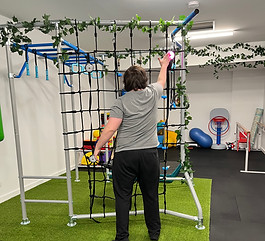ACHIEVING ABILITIES


Active Technology
We often incorporate modern technology into exercise and therapy sessions due to its positive benefit on engagement and physical outcomes. Our Exercise Physiologists can pair our clinical knowledge of movement, the body, various conditions and our individual clients, with our tech tools to develop strength, fitness, reaction time and coordination, balance and agility.
The video, and descriptions, are just a guide to give you an idea of what we can do with them- we are able to adapt their use in countless ways depending on the client and their goals.
Reaction lights
They can be used in a wide range of ways to:
-
Improve gross motor control development
-
Improve whole body coordination
-
Challenge and improve cognitive abilities and balance
-
Add some fun and variety into a session
-
Play games, either solo or with an opponent, to increase the fun, the challenge and get your heart rate up
-
Athletic/sport development and testing (agility, reaction time, speed)


VR Headset
A VR headset isn't just a ‘video game’. This is another way we make Exercise Physiology fun and engaging.
Different games have different focuses, so your Exercise Physiologist will incorporate one that will help you progress to your goals. For example, your Exercise Physiologist may use it to focus on:
-
Rhythmically coordinating limb movements
-
Increasing the need for conscious proprioceptive awareness
-
Balance and reaction time
-
Gross motor skills, motor planning and coordination
-
General muscle strength and cardiorespiratory fitness

LusioMate
Lusio mate uses wearable sensors to turn the body into a controller.The sensors attach to any part of the body and connect via bluetooth to the app to play a range of games. Each player has their own account, where their Exercise Physiologist develops specific movement goals, and selects the appropriate games to support their individual movement goals.
Bobo
The Bobo Board uses an interactive platform to create a gameified experience, again to create a fun and challenging activity, and also allows us to track your progress. The Bobo board is placed on one of our various wobble boards, depending on the goal and individual ability, and connects to a screen to provide the game play visuals.
At Achieving Abilities we use this to support balance, core, and lower limb strength. We adapt it’s use in many ways, and will tailor it’s use to suit you!

Playball
The Playball, is essentially a ‘smart ball’, allowing clients to play interactive games while performing a range of exercises for strength. This one is generally better suited to clients who require specific rehabilitation, or have limited function or mobility in a particular limb or hand. For example, individuals with Cerebral Palsy, injury, other physical disability including, but not limited to, stroke, brain injury. It acts as both a performance measuring tool for us, and a video game controller for the individual.
It’s a great device for improving hand function, upper limb function and mobility, as well as lower limb control and strength.
Hypervibe
The use of the Hypervibe machine is a unique form of therapy that works as a great alternative, or adjunct, to traditional exercise programs and paediatric therapy approaches. It’s a unique form of therapy due to the neuromuscular reflex response it produces. Without getting too technical, the Hypervibe is different from your commercial vibration plates, as it uses high acceleration to stimulate an environment of increased gravity (G-force). Meaning, it creates an environment that gives you many more muscle contractions and stimulation through the neuromuscular system.
Depending on the frequency range, the muscles and body responds in different ways, and helps develop neuromuscular function (strengthening the muscles that are necessary to perform a movement), and neuromuscular communication (the activation of the neuronal system to initiate and control movements).
Those who are not able to stimulate their muscles, or are limited in their ability to do so, can receive a high amount of stimulation to the neuromuscular system, and skeletal system, to help support improvements in their muscular strength, function and bone density.
You don't need to have specific cognitive or motor ability to gain the neuromuscular benefit. Your Exercise Physiologist will prescribe specific exercises suitable to the individuals needs, incorporating the use of other equipment where appropriate.
Most research to date focuses on Cerebral Palsy (CP), and has found significant evidence of beneficial effects on muscle strength, mobility, motor control and bone density in children with CP. However, we find many clients like to spend some time on the Hypervibe doing various activities. It adds some novelty to the session, and is fantastic for increasing strength in those with low muscle tone.
© Achieving Abilities
No images can be reproduced from the website without written permission from Achieving Abilities.